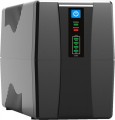Switching to battery
The time required to transfer the load from mains power to battery power. In standby and
interactive UPSs (see Type), a short-term power failure occurs at this moment — accordingly, the shorter the time to switch to the battery, the more uniform the power supply is provided by the source during a power failure. Ideally, the switching time for the traditional 50 Hz AC frequency should be less than 5 ms (a quarter of one cycle of the sine wave). With inverter UPSs, the transfer time is, by definition, zero.
Input voltage range
In this case, the input voltage range is implied, in which the UPS is able to supply a stable voltage to the load only due to its own regulators, without switching to the battery. For redundant UPSs (see "Type") this range is quite small, approximately 190 to 260 V; for interactive and especially inverter ones, it is much wider. Some UPS models allow you to manually set the input voltage range.
Input frequency
The operating frequency of the alternating current supplied to the input of the UPS — or more precisely, the frequency range of this current in which the device can supply the required power to the load due to its own regulators, without using a battery. When this range is exceeded, the UPS switches to battery mode. The smallest input voltage range is reserved for standby UPSs (see "Type"), the largest for inverter UPSs.
Max. output power
The maximum output power supplied by the UPS, in other words, the highest apparent load power allowed for this model.
This indicator is measured in volt-amperes (the general meaning of this unit is the same as that of the watt, and different names are used to separate different types of power). The total power consumption of the load, implied in this case, is the sum of two powers — active and reactive. Active power is actually effective power (it is indicated in watts in the characteristics of electrical appliances). Reactive power is the power wasted by coils and capacitors in AC devices; with numerous coils and/or capacitors, this power can be a fairly significant part of the total energy consumption. Note that for simple tasks, you can use data on effective power (it is often given for UPS — see below); but for accurate electrical calculations it is worth using the full one.
The simplest selection rule for this indicator is: the maximum output power of the UPS in volt-amperes should be at least 1.7 times higher than the total load power in watts. There are also more detailed calculation formulas that take into account the characteristics of different types of load; they can be found in special sources. As for specific values, the most modest modern UPSs give out
700 – 1000 VA, or even
less — this is enough to power a PC of average performance; and in the most "heavyweight" models, th
...is figure can be 8 – 10 kVA and higher.Voltage control
The ability to change the output voltage of the UPS at the request of the user. Electrical networks in different countries have different voltages: for example, in the post-Soviet space, the standard is 230 V, in European countries — 230 V. Small differences in appearance may not play a significant role, however, voltage mismatch can adversely affect the efficiency and durability of electrical appliances.
Voltage regulation allows you to choose the optimal value, thus providing the best conditions for the operation of electronics.
Output voltage distortion
This parameter characterizes the degree of difference between the AC voltage at the output of the UPS and the perfect voltage, the graph of which has the shape of a regular sinusoid. The perfect voltage is so named because it is the most uniform and creates the least unnecessary load on the connected devices. Thus, the distortion of the output voltage is one of the most important parameters that determine the quality of the power received by the load. A distortion level of 0% means that the UPS produces a perfect sine wave, up to 5% — slight sine wave distortion, up to 18% — strong distortion, from 18% to 40% — a trapezoidal signal, more than 40% — a square wave.
Output frequency
The frequency (frequency range) of the AC voltage output by the UPS. For computer technology, the frequency range of 47-53 Hz is considered normal, although the smaller the deviation from the 50 Hz standard, the better. On the other hand, in some UPS models, this frequency can be automatically synchronized with the frequency of the mains — so the power supplied to the load will not differ regardless of whether the load is powered by the mains or from the battery. In this case, a wider frequency range, on the contrary, is more desirable.
Voltage of the 1 battery in set
The value of the operating voltage of one complete battery. In most cases, it is 12 V, UPS with 24-volt batteries is a little less common.
Full charge time
The time it takes to fully charge the UPS battery. Note that in this case, this time is calculated according to special rules: not from 0 to 100% of the charge, but from a state in which it is impossible to maintain half the load, up to 90% of the charge. Of course, a full charge will take a little longer. However, this data is closer to practice than the “from 0 to 100%” calculation: the inability to work at half load makes the UPS practically useless, and this condition can be taken as zero, and 90% of the battery is already able to provide a good guarantee in case of a power failure.

